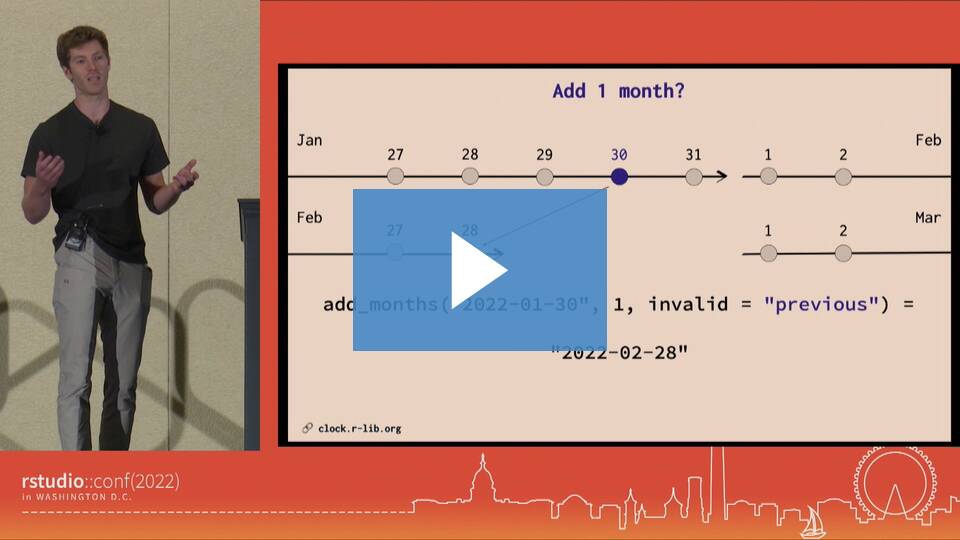clock is an R package for working with date-times. It is packed with features, including utilities for: parsing, formatting, arithmetic, rounding, and extraction/updating of individual components. In addition to these tools for manipulating date-times, clock provides entirely new date-time types which are structured to reduce the agony of working with time zones as much as possible. At a high-level, clock:
Provides a new family of date-time classes (durations, time points, zoned-times, and calendars) that partition responsibilities so that you only have to think about time zones when you need them.
Implements a high level API for R’s native date (Date) and date-time (POSIXct) classes that lets you get productive quickly without having to learn the details of clock’s new date-time types.
Requires explicit handling of invalid dates (e.g. what date is one month after January 31st?) and nonexistent or ambiguous times (caused by daylight saving time issues).
Is built on the C++ date library, which provides a correct and high-performance backend.
There are four key classes in clock, inspired by the design of the C++ date and chrono libraries. Some types are more efficient than others at particular operations, and it is only when all 4 are taken as a whole do you get a complete date time library.
A duration counts units of time, like “5 years” or “6 nanoseconds”. Bigger units are defined in terms of seconds, i.e. 1 day is 86400 seconds and 1 year is 365.2425 days. Durations are important because they form the backbone of clock; it’s relatively rare to use them directly.
A time point records an instant in time, like “1:24pm January 1st 2015”. It combines a duration with a “clock” that defines when to start counting and what exactly to count. There are two important types of time in clock: sys-time and naive-time. They’re equivalent until you start working with zoned-times.
A zoned-time is a time point paired with a time zone. You can create them from either a sys-time or a naive-time, depending on whether you want to convert the time point from UTC (leaving the underlying duration unchanged, but changing the printed time), or declare that the time point is in a specific time zone (leaving the printed time unchanged, but changing the underlying duration). Zoned-times are primarily needed for communication with humans.
A calendar represents a date using a combination of fields like year-month-day, year-month-weekday, year-quarter-day, year-day, or iso-year-week-day, along with hour/minute/second fields to represent time within a day (so they’re similar to R’s POSIXlt). Calendar objects are extremely efficient at arithmetic involving irregular periods such as months, quarters, and years and at getting and setting specified components. A calendar can represent invalid dates (like 2020-02-31) which only need to be resolved when converting back to a time point.
Installation
Install the released version from CRAN with:
install.packages("clock")Install the development version from GitHub with:
# install.packages("pak")
pak::pak("r-lib/clock")Learning
With clock, there is a high-level API for manipulating R’s native date and date-time types (Date, POSIXct, and POSIXlt), as well as a low-level API for more advanced date-time manipulations. The high-level API should allow you to quickly get productive with clock without having to learn many of the new types. An easy way to get an overview of this is by looking at the High Level API section of the pkgdown reference page.
You’ll also want to take a look at clock’s vignettes:
You can also watch this 5 minute lightning talk about clock:
Acknowledgments
The ideas used to build clock have come from a number of places:
First and foremost, clock depends on and is inspired by the date library by Howard Hinnant, a variant of which has been voted in to C++20.
The R “record” types that clock is built on come from vctrs.
The nanotime package was the first to implement a nanosecond resolution time type for R.
The zoo package was the first to implement year-month and year-quarter types, and has functioned as a very successful time series infrastructure package for many years.
Additionally, I’d like to thank my wife for being a power user of clock, and having a number of discussions with me around bugs and missing features. You can thank her for date_count_between().

